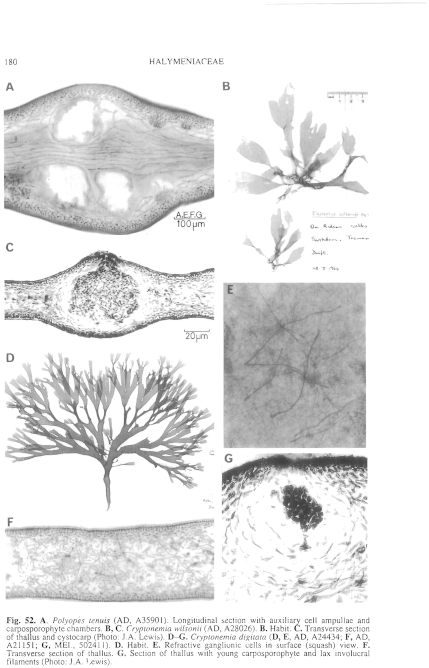|
|
|
|
|
|||||||||||
|
Electronic Flora of South Australia Species Fact Sheet
Phylum Rhodophyta – Class Florideophyceae – Order Gigartinales – Family Halymeniaceae
Synonym
Blastophye wilsonii (J. Agardh) J. Agardh 1892: 72. De Toni 1905: 1618.
Thallus (Fig. 52B) medium to dark red, membranous, 5–17 cm high, complanately and irregularly proliferously but sparsely branched, branches elongate-ovate, 5–15 (–40) mm broad, tapering apically and basally, (50–) 75–170 µm thick (margins 160–240 µm thick), usually with broad, rounded apices. Holdfast discoid, 1–4 mm across; epilithic. Structure (Fig. 52C) of a compact cortex 3–4 (–5) cells and (17–) 20–45 µm thick, outer cells isodiametric and 2–5 (–8) µm across, inner cells subspherical to ovoid, becoming angular and slightly stellate and 8–15 µm across, with a medulla (20–) 50–100 µm thick (0.2–0.5 of thallus thickness), of entwined filaments 3–6 µm in diameter and a network of connected refractive ganglioid cells with evenly staining contents, slightly swollen to ovoid central regions and long slender arms (with occasional swellings) remaining pit-connected to arms of other ganglioid cells. Rhodoplasts discoid to irregular, few per cell.
Reproduction: Carpogonial branch ampullae relatively simple with few secondary filaments. Auxiliary cell ampullae also with few secondary filaments. Carposporophytes (Fig. 52C) subglobose, 120–200 µm across, centrally situated in the medulla, with basal auxiliary cell, slight involucre and small ostiole. Spermatangia not seen.
Tetrasporangia scattered in the outer cortex, cruciately divided.
Type from Port Phillip Heads, Vic; lectotype (Wilson 75, 5.ii.1883) in Herb. Agardh, LD, 24812. The lectotype was selected from several Port Phillip Heads specimens of Wilson, in Herb. Agardh, being collected prior to the publication date. The branches are generally narrower than in most specimens of this species.
Selected specimens: South Channel, Port Phillip, Vic. (Wilson, 26.i.1884; MEL, 1005805). Port Phillip Heads, Vic. (Wilson, 11.i.1883; MEL, 1005803). South Arm, Tas., on cockles, drift (Wollaston & Mitchell, 28.ii.1964; AD, A28026). Ninepin Point, SE Tas., 10–13 m deep (Kraft, 3.i.1993; MELU, A40411–40413).
Distribution: Port Phillip Heads, Vic., and SE Tasmania.
Taxonomic notes: C. wilsonii was first described by J. Agardh (1885, p. 25) and subsequently used to typify his new genus Blastophye (J. Agardh 1892, p. 72). However, the vegetative structure and reproduction in this species appears similar to other Cryptonemia species. Although C. wilsonii lacks the well-developed stipe and/or midrib often used to characterise the latter genus, a number of other species presently ascribed to Cryptonemia also lack these characters, for example C. obovata J. Agardh (Guiry & Irvine 1974, p. 234), C. papenfussii Chiang (Chiang 1970, p. 54, figs 25, 26, pl. 6b) and C. limensis (Kützing) Lewis (Lewis 1990). Further studies are warranted to clarify the relationship between these and the generic type, C. lomation (Bertolini) J. Agardh from the Mediterranean, and to characterise better the genus Cryptonemia as a whole. In the interim, the broader generic concept of Cryptonemia is accepted and C. wilsonii is returned to that genus.
Blastophye phyllophora (J. Agardh) J. Agardh (1892, p. 72) from Vancouver I., Canada, appears to need re-investigation; it may be the same as Opuntiella californica (Farlow) Kylin (pers. comm. R.F. Scagel).
References:
AGARDH, J.G. (1885). Till algemes systematik. VII. Florideae. Acta Univ. lund. 21, 1–120, Plate 1.
AGARDH, J.G. (1890b). Descriptions of new Victorian algae. (Translated by J. Bracebridge Wilson.) Rep. Second Meeting Australasian Ass. Adv. Sci., Melbourne, Vic. Proc. Sect. D, pp. 488–491.
AGARDH, J.G. (1892). Analecta Algologica. Acta Univ. lund. 28, 1–182, Plates 1–3.
CHIANG, Y.-M. (1970). Morphological studies of red algae of the family Cryptonemiaceae. Univ. Calif Pubis Bot. 58, 1–83, Plates 1–10.
DE TONI, G.B. (1905). Sylloge Algarum omnium hucusque Cognitarum. Vol. 4. Florideae. Sect. 4, pp. 1523–1973. (Padua.)
GUIRY, M.D. & IRVINE, L.M. (1974). A species of Cryptonemia new to Europe. Br. phycol. J. 9, 225–237.
LEWIS, J.A. (1990). Cryptonemia limensis (Kützing)Lewis, comb. nov. (Halymeniaceae, Rhodophyta) from Peru. Taxon 39, 98–104.
The Marine Benthic Flora of Southern Australia Part IIIA complete list of references.
Publication:
Womersley, H.B.S. (14 January, 1994)
The Marine Benthic Flora of Southern Australia
Rhodophyta. Part IIIA, Bangiophyceae and Florideophyceae (to Gigartinales)
Reproduced with permission from The Marine Benthic Flora of Southern Australia Part IIIA 1994, by H.B.S. Womersley. Australian Biological Resources Study, Canberra. Copyright Commonwealth of Australia.
Illustration in Womersley Part IIIA, 1994: FIGS 52B, C.

Figure 52 enlarge
Fig. 52. A. Polyopes tenuis (AD, A35901). Longitudinal section with auxiliary cell ampullae and carposporophyte chambers. B, C. Cryptonemia wilsonii (AD, A28026). B. Habit. C. Transverse section of thallus and cystocarp (Photo: J.A. Lewis). D–G. Cryptonemia digitata (D, E, AD, A24434; F, AD, A21151; G, MEL, 502411). D. Habit. E. Refractive ganglionic cells in surface (squash) view. F. Transverse section of thallus. G. Section of thallus with young carposporophyte and lax involucral filaments (Photo: J.A. Lewis).

|
Email Contact: State Herbarium of South Australia |

|